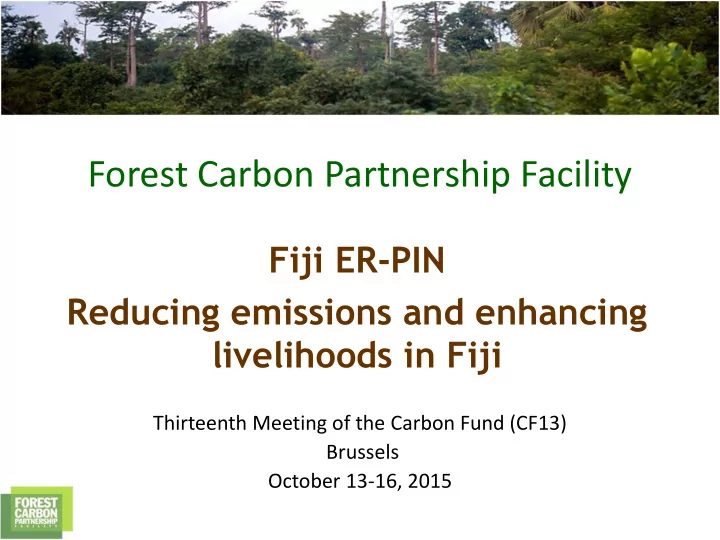

Forest Carbon Partnership Facility Fiji ER-PIN Reducing emissions and enhancing livelihoods in Fiji Thirteenth Meeting of the Carbon Fund (CF13) Brussels October 13-16, 2015
Fiji ER-PIN ER Program Idea Background/Context • Fiji has over 13,000 communities that depend directly on the limited Fiji land use cover Forest categories natural resources • The REDD+ strategy aims at overall sustainable management and increase of forest stocks to secure present and future livelihoods for the communities • The ERPA will cover 94 % of Fiji’s forest areas and contribute Forest Land significantly to the national REDD+ strategy Grassland Natural forest Cropland • REDD+ development is guided by and aligned with relevant national Pine pl. Wetlands Hardwood pl. plans (policies, strategies) Settlements Mangroves • Safeguard standards are traditionally high Other Land Fiji will implement an emission reduction programme! Inclusion in the Carbon Fund will greatly enhance quality and speed of its realisation. 2
Fiji ER-PIN Political commitment 1. Continued support of high-level bodies 2. Supporting national policies, legislations and development plans 3. Committed multi-sectoral REDD+ Steering Committee members 4. Strong participation of local communities, decentralized governance 5. Annual government budget and in-kind allocation for REDD+ and related activities 6. International / national commitments: INDC, UNFCCC (currently chair of SBI) , CBD and others 3
Fiji ER-PIN Program highlights • Co-benefits generated will be significant • Projected emission reductions: 2,960,500.51 tCO 2 • Main activities: afforestation / reforestation, forest protection, improved forest management • ERP designed to potentially benefit all of Fiji • Emphasis on enhancing livelihoods • Broad stakeholder participation framework established • Synergy created with government-supported community development programmes to ensure holistic development 4
Fiji ER-PIN Country progress towards Readiness Legal Framework: Institutional Framework: 1. Green Growth Framework 1. REDD+ Steering Committee 2. REDD+ Policy 2. REDD+ Divisional Working Groups 3. REDD+ Lease 3. National iTaukei Resource Owner 4. Land Use Planning Policy Committee 5. Forest Decree in development 4. CSO Platform 5. Soqosoqo Vakamarama (Women’s NGO) RL / MRV: Safeguards: 1. Preliminary assessments 1. SESA elements already undertaken 2. Lessons learnt from pilot sites 2. Constitutional land owner rights 3. Capacity development 3. Established safeguard structures 4. FPIC guidelines Way forward: 1. Development of national RL, NFMS, 4. Mid-term Review (2017) SESA: 2016 / 2017 5. National carbon registry to be established 2. Expansion and upscaling of pilot end of 2017 activities 6. R-Package (national strategy) ready in 3. National consultations on REDD+ 2018 5 Strategy (2016, 2017) 7. ER-PD submission in 2018
Fiji ER-PIN Scale Main islands of Viti Levu, Vanua Levu, Taveuni 100% 90% 80% 70% 60% Fiji total 50% ERPA 40% 30% 20% 10% 0% Land area Forest area 6
Fiji ER-PIN Drivers and proposed program activities The identified activities respond to the main drivers: Activities Drivers Afforestation / reforestation in Regular fires maintain grasslands grasslands and degraded forests and open forests Unplanned logging (degradation) Improved forest management / Agriculture / slash’n’burn practice, protection also in prohibited locations (semi- commercial deforestation) Improved forest management / Conventional logging practices enhancement planting (degradation) 7
Fiji ER-PIN Preliminary Reference Level Afforestation / reforestation S table grassland cover, no plantations or reforestation; frequent burning Carbon stocks in balance (low storage) Protection of threatened Farming and logging encroaching onto native forests HCV forest areas Annual emissions: 346,807.66 tCO 2 Sustainable forest Conventional logging practices prevail management Annual emissions: 252,000 tCO 2 Baseline period: 1991- 2010 Data sources: surveys / assessments in Fiji 8
Fiji ER-PIN Emission Reductions Generated Fiji Emission Reductions Programme Estimated CO 2 emissions savings and removals Average Total carbon Average area Total carbon Total emission Average logging accumulated emission under forest emission removals for area under SFM reforested area savings from protection for savings (forest each period regime for each for each period sustainable each period protection) (tCO 2 ) period (ha) (ha) logging (tCO 2 ) (ha) (tCO 2 ) year Pre- 2015 – ERPA 8,640 253,670.4 425 225,043.3 45,000 29,181 2018 period 2019 - ERPA 38,523.33 1,696,567.6 1,250.0 992,838 218,750 905,184.56 2024 Post- 2025 – ERPA 72,993.3 3,214,626.9 1,250.0 992,838 352,500 1,458,640.27 2030 period Buffer: 15% 20% 20% Total Carbon 1,442,082.46 794,270.40 724,147.65 credits ERPA 9 2,960,500.51 tCO 2 Total:
Fiji ER-PIN Major sources of funding Funding source Activity Total (FJD) REDD+ national process and pilot site 300,000 annually Fiji Forestry Reforestation Development Fund 500,000 annually Department Technical support for pine resin tapping 400,000 annually (value-adding to the forest) SPC / EU Reforest Fiji: fire prevention, re / Ca. 17M (2013- afforestation in grassland areas 2018) NGOs, CSOs, private Various re / afforestation projects Unknown (planting sector, communities throughout Fiji targets to be met) Germany (BMZ, Advisory services for many different Undefined BMU) elements of REDD+ implementation (SFM and forest protection) and ERP framework (participatory process, monitoring) 10
Fiji ER-PIN Non-carbon benefits 11
Fiji ER-PIN Diversity and learning value Contributions from Fiji to international exchange 1. Successful implementation of REDD+ in small countries 2. Implementation of REDD+ in a largely communal & customary land tenure system (main land tenure system in the Pacific) 3. REDD+ programme planning incorporates activities to increase resilience of local communities against the impacts of climate change 4. Creation of synergies between externally funded carbon projects and government community development / livelihoods programmes. Integration of these activities into a common national framework 5. Risk of reversal and local displacement mitigated by effective delivery of co-benefits and NCBs; and size of ERP area 6. Measuring forest degradation: reference levels, incentives, monitoring 7. Local scientists engaging local communities in joint carbon stock and biodiversity assessment and monitoring 12
Recommend
More recommend